- Last Updated: December 16th, 2025
Key Takeaways
PCBs were once ubiquitous in industrial applications due to their desirable physical and chemical properties.
Health and environmental concerns have led to their regulation and discontinuation.
Contamination from PCBs persists, necessitating ongoing cleanup and management strategies.
Overview of PCB Chemicals
On this page, we’ll discuss an overview of PCB chemicals, historical background of PCB use and production, the environmental and health impacts of PCB exposure, and much more.
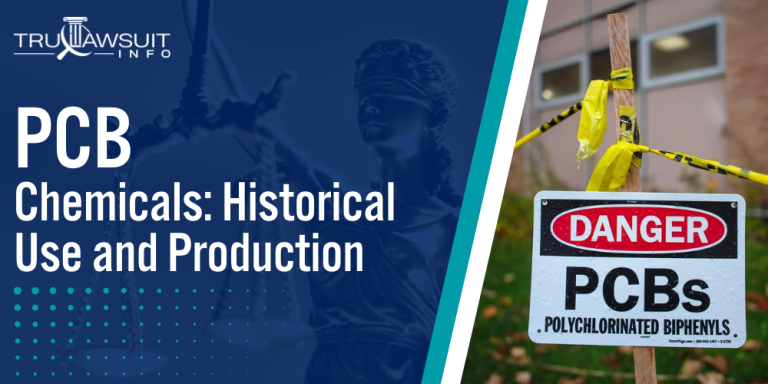
Intro To PCB Chemicals
PCBs, or polychlorinated biphenyls, are a group of man-made organic chemicals that were widely used in various industrial and commercial applications due to their non-flammability, chemical stability, high boiling point, and electrical insulating properties.
Here are some key facts about the historical use and production of PCB chemicals:
- PCBs were commercially produced from 1929 until their manufacture was banned in 1979.
- They were used in hundreds of industrial and commercial applications including electrical, heat transfer, and hydraulic equipment.
- PCBs were also used in plasticizers in paints, plastics, and rubber products, in pigments, dyes, and carbonless copy paper.
- More than 1.5 billion pounds of PCBs were manufactured in the United States prior to the 1979 ban.
If you or a loved one has experienced adverse health conditions after being exposed to PCB chemicals, you may qualify to pursue compensation.
Contact TruLawsuit Info using the chat on this page to receive an instant case evaluation to determine if you qualify to file a PCB lawsuit today.
History of PCB Chemical Production
On this page, we’ll discuss an overview of the early discovery of PCBs, Monsanto’s dominance in PCB manufacturing, the contexts of global PCB production, and much more.
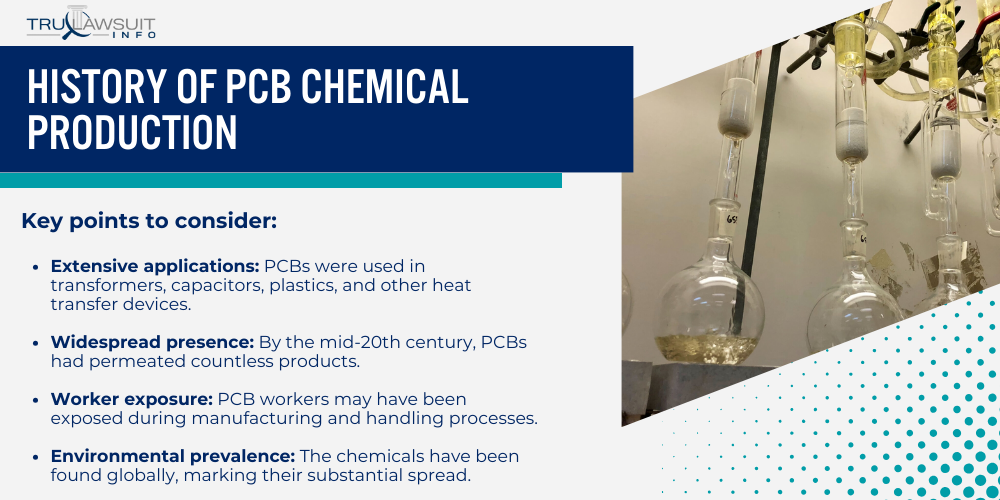
Early Discovery and Widespread Use of PCBs
Polychlorinated biphenyls (PCBs) were first synthesized in 1881, but their commercial production didn’t begin until the 1920s.
They became highly valued for industrial applications due to their chemical stability, high boiling point, and non-flammability.
These characteristics led to their widespread use in a variety of products and equipment.
Key points to consider:
- Extensive applications: PCBs were used in transformers, capacitors, plastics, and other heat transfer devices.
- Widespread presence: By mid-20th century, PCBs had permeated countless products.
- Worker exposure: PCB workers may have been exposed during manufacturing and handling processes.
- Environmental prevalence: The chemicals have been found globally, marking their substantial spread.
Monsanto’s Dominance in PCB Manufacturing
Monsanto was the primary manufacturer of PCBs in the United States and produced the majority of PCBs used worldwide from 1930 until production ceased.
Their brand of PCBs, marketed as Aroclors, became synonymous with the compounds.
Key points to consider:
- Market control: Monsanto held a monopoly over the PCB market in the United States.
- Chemical variation: A range of Aroclors was developed, varying in chlorine content.
- Manufacturing halt: Production of Aroclors stopped in 1977 following evidence of their environmental and health impacts.
- Global effect: Monsanto’s PCBs had not only national but also global ramifications, influencing production practices worldwide.
Global PCB production saw rapid growth due to industrial demand; however, it was met with mounting concern over pollution and health risks.
This led to the reduction and eventual stop of commercial production as regulations came into force.
Workers in the PCB industry, often referred to as PCB workers, were among the first to raise alarms about potential health risks associated with these chemical compounds.
Health Risks Associated with PCB Exposure
Exposure to Polychlorinated Biphenyls (PCBs) can lead to a range of health risks, from skin conditions to more serious diseases.
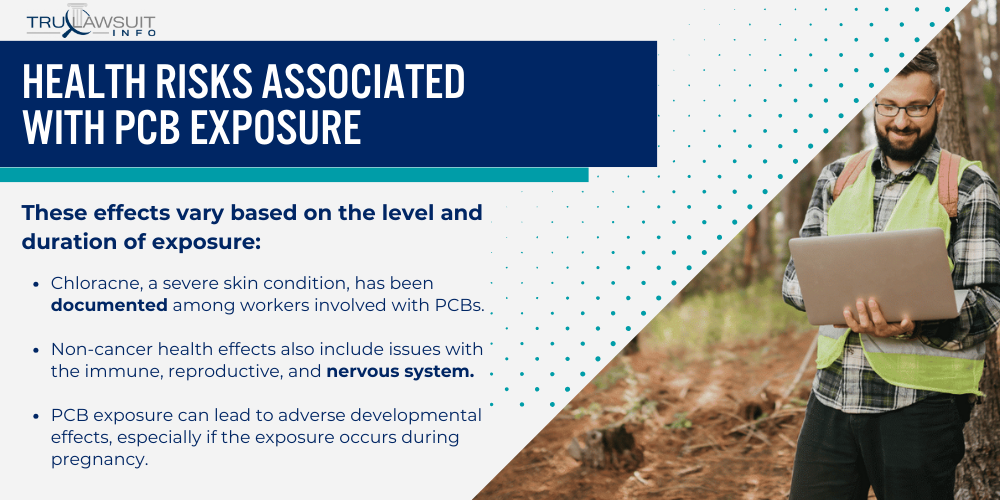
PCBs are classified as probable human carcinogens and their impact, although largely historical, still poses risks in contaminated environments.
Adverse Effects on Human Health
PCBs have been associated with a variety of health problems in humans.
These effects vary based on the level and duration of exposure:
- Chloracne, a severe skin condition, has been documented among workers involved with PCBs.
- Non-cancer health effects also include issues with the immune, reproductive, and nervous system.
- PCB exposure can lead to adverse developmental effects, especially if the exposure occurs during pregnancy.
- There is evidence linking PCBs with increased risk of certain types of cancer, supporting their classification as probable human carcinogens.
Bolded lead-in sentences help emphasize the critical points.
Detailed effects can be further explored in a comprehensive review of worker exposure.
Environmental Impact of PCB Contamination
PCBs, or Polychlorinated Biphenyls, are a group of man-made chemicals that were widely used in the past but are now banned due to their hazardous properties.
Their persistence in the environment and ability to bioaccumulate in living things create a long-lasting environmental problem.
The environmental health consequences of PCB contamination are significant:
- PCBs are persistent organic pollutants; once released into the environment, they do not degrade easily.
- They can accumulate in the fatty tissues of living organisms, leading to bioaccumulation and biomagnification.
- Contaminated fish and wildlife can convey the chemicals to humans and other species, posing indirect health risks.
- Widespread PCB contamination can also affect air, water, and soil quality and constitutes an ongoing environmental concern.
Consider the pervasive nature of these compounds and how they can impact both human health and the environment.
Additional insights into environmental pathways can be gained through the Public Health Statement for PCBs.
This section underscores the importance of understanding the broad and serious implications of PCB exposure for both humans and the environment, reflecting the continued relevance of this issue.
Regulation and Phaseout of PCB Chemicals
Polychlorinated biphenyls (PCBs) have a significant regulatory history due to their environmental impact and longevity.
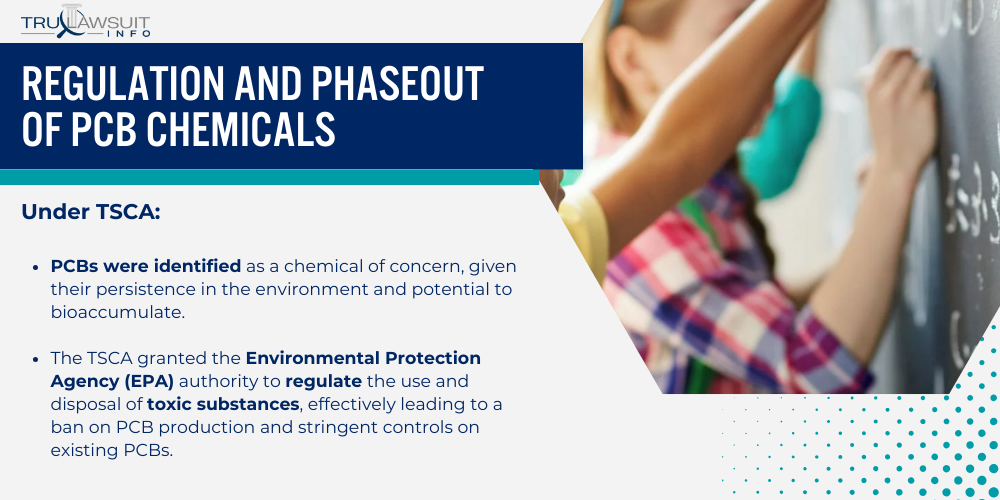
The two pivotal areas in the regulatory landscape include the United States’ domestic legislation and broader global agreements.
The Toxic Substances Control Act of 1976
The Toxic Substances Control Act (TSCA) of 1976 was a major legislative response to the increasing awareness of environmental and human health risks posed by toxic substances like PCBs.
Under TSCA:
- PCBs were identified as a chemical of concern, given their persistence in the environment and potential to bioaccumulate.
- The TSCA granted the Environmental Protection Agency (EPA) authority to regulate the use and disposal of toxic substances, effectively leading to a ban on PCB production and stringent controls on existing PCBs.
- Comprehensive regulations on the PCB disposal and use of existing PCB chemicals were implemented, reinforcing the transition away from PCB reliance in industrial applications.
- EPA’s updates to PCB regulations, effective February 26, 2024, aim to address key issues related to PCB cleanup and disposal.
Further changes in PCB regulations were announced, which continued the advancement of TSCA’s goals by clarifying and modifying the rules around the clean-up and appropriate disposal methods for PCBs.
Global Efforts to Ban PCB Production and Use
On a global scale, concerted efforts have been made to halt PCB production and curtail its use.
Here’s what has unfolded internationally:
- The Stockholm Convention on Persistent Organic Pollutants, an international environmental treaty signed in 2001, targeted PCBs for elimination because they are classified as persistent organic pollutants (POPs).
- The goal was to phase out PCB use by 2025 and responsibly dispose of PCBs in equipment by 2028.
- A wide range of countries have committed to eliminating PCBs, reflecting a global consensus on their health and environmental risks.
- The effectiveness of these bans and phase-out programs has been significant in reducing global PCB production levels and emissions.
Historically, many nations contributed to global PCB production, with the chemical’s usage peaking before widespread bans and phaseout efforts took effect.
The international response has been pivotal in reducing the presence of PCBs in the environment, though the persistence of legacy PCBs remains a challenge to be addressed.
Legacy PCB Contamination in the Environment
Polychlorinated biphenyls (PCBs) are persistent pollutants that continue to pose environmental challenges due to their propensity to remain in ecosystems long after their initial release.
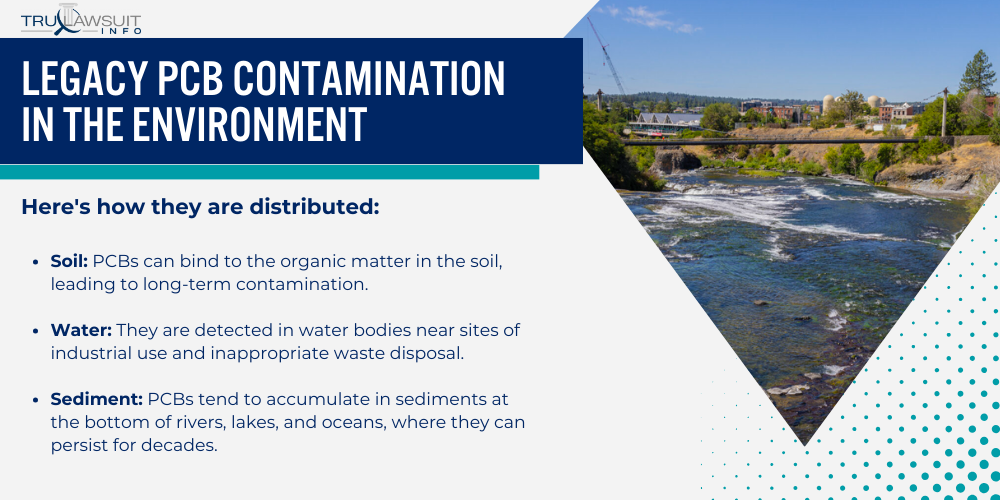
This section explores the pervasive nature of PCBs in soil, water, and sediment, as well as their tendency to bioaccumulate in the food chain.
PCBs in Soil, Water, and Sediment
Upon their introduction into the environment, PCBs have a long-lasting impact on various mediums.
Here’s how they are distributed:
- Soil: PCBs can bind to the organic matter in the soil, leading to long-term contamination.
- Water: They are detected in water bodies near sites of industrial use and inappropriate waste disposal.
- Sediment: PCBs tend to accumulate in sediments at the bottom of rivers, lakes, and oceans, where they can persist for decades.
The significance of PCB wastes from contaminated equipment and materials cannot be overstated, as they are ongoing sources of environmental pollution.
Bioaccumulation of PCBs in the Food Chain
PCBs have the precarious tendency to move up the food chain, culminating in contaminated food for both wildlife and humans.
Their journey through the food web involves:
- Microorganisms: PCBs are absorbed by microscopic life forms in water and soil.
- Aquatic Life: Small aquatic organisms ingest PCBs and are then eaten by larger fish.
- Birds and Mammals: They consume contaminated fish, leading to higher concentrations of PCBs.
- Humans: People are exposed through the consumption of contaminated food, particularly fish and other seafood.
The cumulative effect of these compounds can be particularly severe for top predators due to the concentration of PCBs as one ascends the food chain.
Remediation Techniques for PCB-Contaminated Sites
Effective management of PCB contamination is imperative for safeguarding environmental health.
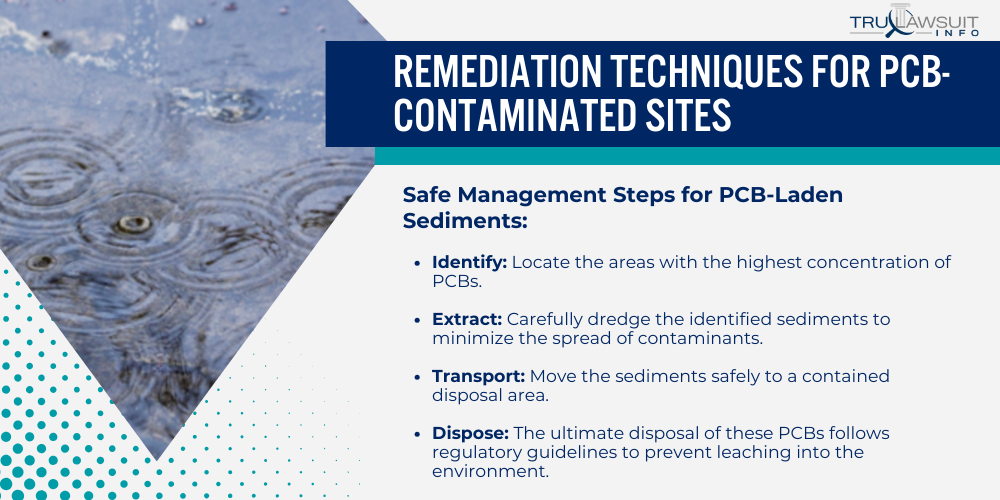
This section explores established methods to tackle PCB-laden sediments and PCB waste utilizing both mechanical and biological approaches.
Dredging and Disposal of PCB-Laden Sediments
Sediments contaminated with PCBs often require dredging—a process involving the careful removal of these sediments from water bodies.
After dredging, proper disposal methods are crucial to ensuring these chemical compounds do not further harm the environment.
Safe Management Steps for PCB-Laden Sediments:
- Identify: Locate the areas with the highest concentration of PCBs.
- Extract: Carefully dredge the identified sediments to minimize the spread of contaminants.
- Transport: Move the sediments safely to a contained disposal area.
- Dispose: The ultimate disposal of these PCBs follows regulatory guidelines to prevent leaching into the environment.
Bioremediation and Chemical Treatment Methods
Bioremediation employs living organisms to degrade PCBs, turning hazardous waste into less harmful substances.
Chemical methods involve the application of chemical reactions to neutralize or destroy PCB compounds.
Following bioremediation or chemical treatment, these steps are essential to ensure successful PCB removal:
- Selection: Choose appropriate microbes or chemicals that can break down PCBs.
- Optimization: Adjust conditions to maximize the efficiency of the bioremediation process.
- Monitoring: Keep a close watch on the treatment to observe progress and make necessary adjustments.
- Completion: Once the PCB levels are reduced to safe concentrations, confirm through testing.
Ongoing Challenges in Managing PCB Chemicals
Managing PCB chemicals continues to be a significant environmental and public health challenge due to their persistence and widespread previous use.
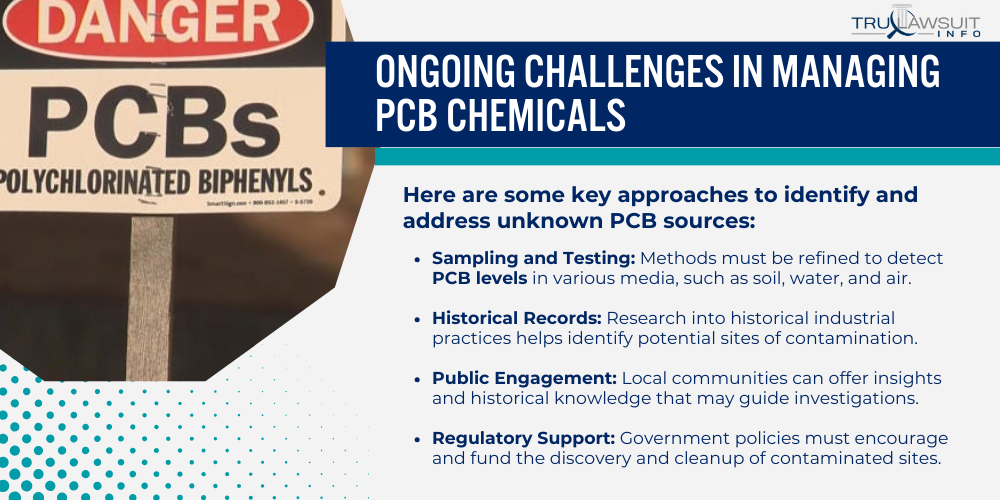
Two specific areas require attention to reduce PCB exposure and mitigate the risks associated with these hazardous compounds.
Identifying and Addressing Unknown PCB Sources
Efforts to pinpoint and control unknown sources of PCBs are fraught with difficulties.
Industrial sites, landfills, and old buildings may all harbor hidden PCBs, which can leach into the environment.
Here are some key approaches to identify and address unknown PCB sources:
- Sampling and Testing: Methods must be refined to detect PCB levels in various media, such as soil, water, and air.
- Historical Records: Research into historical industrial practices helps identify potential sites of contamination.
- Public Engagement: Local communities can offer insights and historical knowledge that may guide investigations.
- Regulatory Support: Government policies must encourage and fund the discovery and cleanup of contaminated sites.
Developing Safer Alternatives to PCBs in Industrial Applications
Finding and promoting safe substitutes for PCB chemicals in industrial applications is essential to preventing future contamination.
Here are some strategies to achieve this goal:
- Research Investments: Increase funding for developing non-toxic materials with similar properties to PCBs.
- Adoption Incentives: Financial or regulatory incentives to encourage industries to switch to safer alternatives.
- Product Reformulation: Encourage manufacturers to redesign existing commercial PCB products to be PCB-free.
- Education and Outreach: Inform industries of the risks of PCBs and the benefits of alternatives to foster transition.
Legislation and technology are both pivotal in addressing the ongoing challenges in managing PCB chemicals.
While significant progress has been made to reduce PCB levels and exposure, additional measures are vital to protect human health and the environment from these persistent contaminants.
The Role of Corporations in the PCB Crisis
Corporations have played a significant role in developing and continuing the PCB crisis, impacting public health and environmental quality.
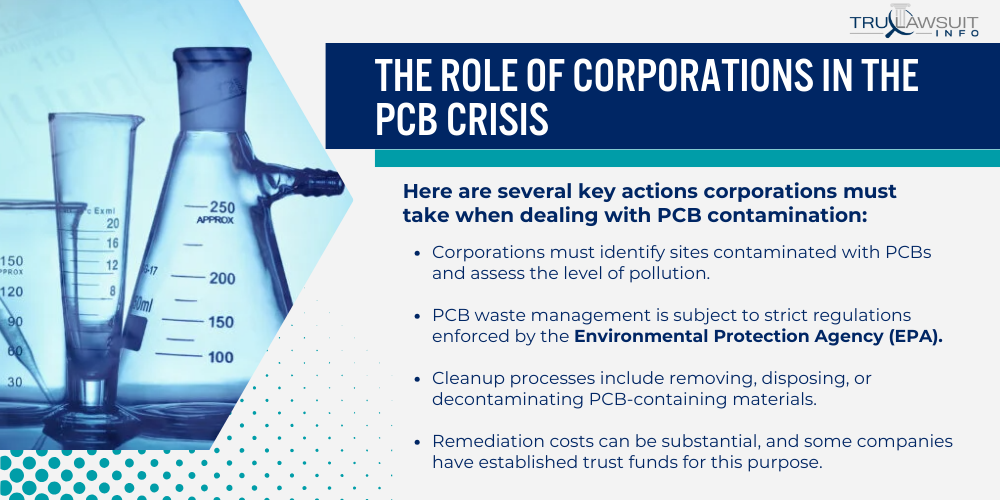
Their responsibilities span across the production, usage, and cleanup of PCBs, as well as influencing regulations and public opinion.
Liability and Responsibility for PCB Cleanup Efforts
Corporations that once manufactured or used PCBs are often held liable for cleanup efforts.
This responsibility stems from environmental laws mandating the remediation of contaminated sites.
Here are several key actions corporations must take when dealing with PCB contamination:
- Corporations must identify sites contaminated with PCBs and assess the level of pollution.
- PCB waste management is subject to strict regulations enforced by the Environmental Protection Agency (EPA).
- Cleanup processes include removing, disposing, or decontaminating PCB-containing materials.
- Remediation costs can be substantial, and some companies have established trust funds for this purpose.
Examples of corporate involvement in PCB remediation can be seen in the case of the Monsanto Corporation, a major U.S. producer of PCBs, which marketed its PCB products primarily under trade names such as Aroclor.
Corporate Influence on PCB Regulation and Public Perception
Corporations have historically influenced the regulation of PCBs and shaped public perception regarding their safety and environmental impact.
These efforts can be seen through several tactics:
- Corporate lobbying efforts have aimed at shaping PCB regulations that affect their operations.
- Companies have funded research to assess the impact of PCBs, which can affect public health narratives.
- Public relations campaigns have alleviated public concern about PCBs’ environmental health impacts.
- Transparency in corporate practices concerning PCBs has varied, affecting public trust.
The influence of corporate actions on PCB regulation and public perception is not just historical but ongoing.
Various stakeholder groups and environmental organizations closely monitor it.
Lessons Learned from the PCB Chemical Era
Industry and regulatory bodies have gleaned significant insights regarding chemical management and policy in the wake of the PCB chemical era.
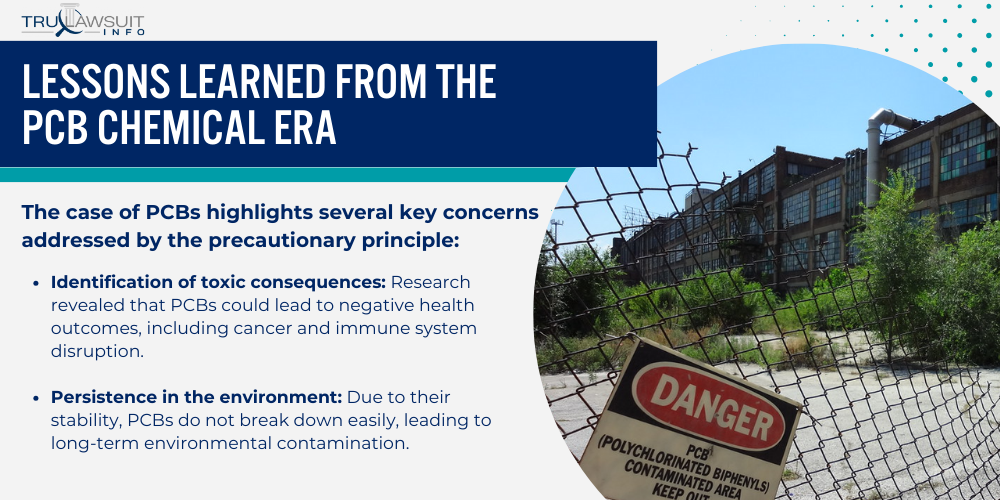
Importance of Precautionary Principle in Chemical Regulation
Polychlorinated biphenyls (PCBs) present a classic example of why the precautionary principle should be a cornerstone in chemical regulation.
PCBs, once celebrated for their chemical stability and heat-resistant properties, were later revealed to be toxic substances with far-reaching environmental impacts.
The case of PCBs highlights several key concerns addressed by the precautionary principle:
- Identification of toxic consequences: Research revealed that PCBs could lead to negative health outcomes, including cancer and immune system disruption.
- Persistence in the environment: Due to their stability, PCBs do not break down easily, leading to long-term environmental contamination.
- Bioaccumulation in wildlife: PCBs belong to the food chain, harming animals and potentially affecting human health through diet.
- Global distribution: PCBs have been found in remote areas, indicating that chemicals can disperse far beyond their point of use.
These observations underscore the importance of a proactive approach to chemical regulation, ensuring safety before widespread use.
Need for Increased Transparency and Accountability in Industry
The manufacturing and application of PCB chemicals in commercial PCB mixtures demonstrated the critical need for increased transparency and accountability within the industry.
To achieve this, several key measures are required:
- Full disclosure of chemical properties: Companies must provide comprehensive data on chemical substances, including potential hazards.
- Long-term impact studies: Industries should assess the long-term environmental and health impacts of chemicals before they are brought to market.
- Regulatory enforcement: The Environmental Protection Agency (EPA) plays a vital role in enforcing regulations to protect public and environmental health.
- Responsible disposal: Companies must ensure proper disposal to prevent the release of hazardous chemicals into the environment.
This focus on transparency and accountability aims to prevent future instances where chemicals, initially thought harmless, lead to lasting environmental damage.
Frequently Asked Questions
-
Chlorinated hydrocarbons were widely used due to their chemical stability and insulating properties.
They have been utilized in electrical devices and equipment like transformers and capacitors, as well as in heat transfer fluids, flame retardants, and hydraulic systems.
-
PCBs contribute to environmental pollution through leaks, improper disposal, and accidents.
Their persistence in the environment leads to long-term contamination of soil, water bodies, and food chains, affecting numerous species over time.
-
Products that commonly contained PCB chemicals included electrical equipment such as transformers, capacitors, and voltage regulators.
Other items with PCBs were certain types of hydraulic fluids, plasticizers, and heat exchange fluids.
-
PCBs are considered toxic due to their ability to cause various adverse health effects, such as cancer and reproductive issues.
They accumulate in the body over time and can lead to immunotoxic, neurotoxic, and endocrine-disrupting effects.
-
PCBs have been legally banned in many countries, including the United States, countries in the European Union, and Japan.
The Stockholm Convention On Persistent Organic Pollutants, which most countries have ratified, mandates the elimination of PCBs.
-
Typical examples of polychlorinated biphenyl compounds span Aroclor in the United States and Kanechlor in Japan.
These are trade names for PCB congeners and mixtures used in various industrial applications.

Attorney Jessie Paluch, founder of TruLawsuit Info, has over 25 years of experience as a personal injury and mass tort attorney, and previously worked as an international tax attorney at Deloitte. Jessie collaborates with attorneys nationwide — enabling her to share reliable, up-to-date legal information with our readers.
Legally Reviewed
This article has been written and reviewed for legal accuracy and clarity by the team of writers and legal experts at TruLawsuit Info and is as accurate as possible. This content should not be taken as legal advice from an attorney. If you would like to learn more about our owner and experienced injury lawyer, Jessie Paluch, you can do so here.
Fact-Checked
TruLawsuit Info does everything possible to make sure the information in this article is up to date and accurate. If you need specific legal advice about your case, contact our team by using the chat on the bottom of this page. This article should not be taken as advice from an attorney.
You can learn more about the PCB Exposure Lawsuit by visiting any of our pages listed below:
Here, at Tru Lawsuit Info, we’re committed to helping victims get the justice they deserve.
To do this, we actively work to connect them with attorneys who are experts in litigating cases similar to theirs.
Table of Contents
Tru Lawsuit Info is a reliable source of information about issues that may affect your health and safety, such as faulty products, data breaches, and environmental hazards.
Our team of experienced writers collaborates with medical professionals, lawyers, and advocates to produce informative articles, guides, and other resources that raise awareness of these topics.
Our thorough research provides consumers with access to reliable information and updates on lawsuits happening around the country. We also can connect consumers with attorneys if they need assistance.
Here, at Tru Lawsuit Info, we’re committed to helping victims get the justice they deserve.
To do this, we actively work to connect them with attorneys who are experts in litigating cases similar to theirs.
